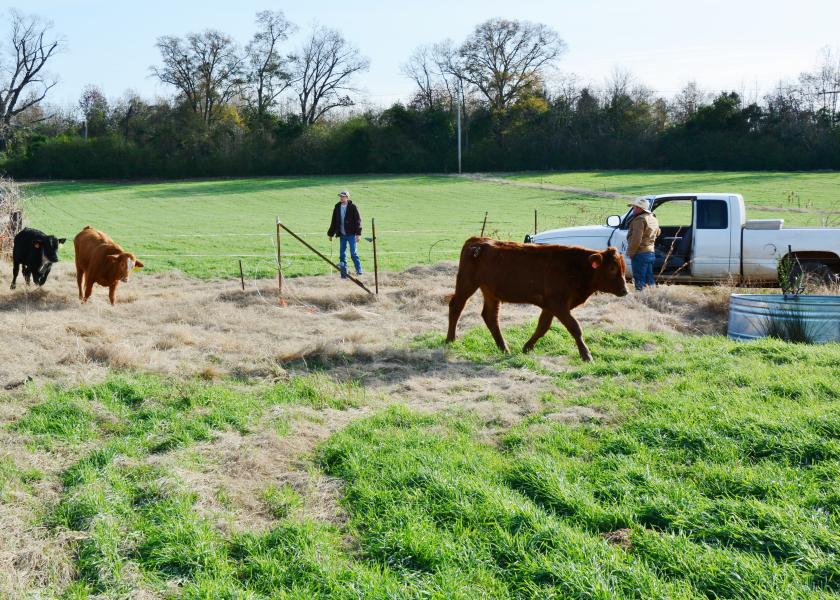Forage Producers Face High Input Costs, Drought

Higher fertilizer prices and poor precipitation outlook could mean thin margins and little room for error for cattle and forage producers this year, according to a Texas A&M AgriLife Extension Service expert.
Vanessa Corriher-Olson, Ph.D., AgriLife Extension forage specialist, Overton, said input costs and weather conditions now and those forecasted should be on forage and cattle producers’ minds as they prepare for warm-season grass production.
It may feel cooler than usual, but temperatures were on par for a typical March, she said. Temperatures were still dipping into the 40s at night for much of the state, which means warm-season grasses have not started to actively grow.
Corriher-Olson said producers need to be patient and hold off on fertilizing hay meadows and grazing pastures until nighttime temperatures are 60 degrees consistently. For example, Bermuda grass does not begin to actively grow and take in nutrients until soil temperatures reach 65 degrees.
“It seems like every year I see producers starting to fertilize way too early,” she said. “They see everything turning green and they think it’s time. It’s time to locate a source, but not time to apply until temperatures warm.”
Fertilizer expense
Corriher-Olson said producers need to be especially mindful of when and how much nitrogen, phosphorous and potassium they apply because prices for most fertilizers and nutrients have increased compared to last year. Recent price checks in East Texas showed diammonium phosphate was $695 per ton; ammonium nitrate was $500 per ton; potash was $465 per ton and ammonium sulfate was $360 per ton.
“Fertilizer prices will be a big challenge for some producers, so they will need to base their decisions on soil tests,” she said. “If they want to cut costs, they need to cut across the board. Don’t focus your investment on nitrogen and forgo potassium or phosphorous. Cutting one for the other creates a nutrient imbalance in the soil.”
Corriher-Olson said producers might find less expensive alternatives like poultry litter or animal manure if proximity makes them economically feasible. However, she said, be careful when searching for low-cost alternatives because non-traditional sources are marketed heavily when traditional fertilizer costs are high.
“These non-traditional sources may make bold claims, so be wary of something that sounds too good to be true,” she said. “Seek out unbiased opinions, your local county agent or soil and forage specialists to determine the value of what you’re buying.”
Drought concerns
The threat of drought is another challenge that could translate into lower production, which compounds higher input costs, Corriher-Olson said.
A recent National Oceanic and Atmospheric Administration drought outlook for Kansas, Oklahoma and Texas reported worsening conditions for Texas. Western and southern parts of the state were in extreme to exceptional drought, while drought conditions throughout Central Texas reached moderate to severe levels. Conditions were not expected to improve through June.
“Even some parts of East Texas are drying down, so producers need to utilize the moisture to the greatest benefit whether it’s for forage production or grazing,” she said. “We can hope for rain, but producers need to be preparing for drier-than-normal conditions and considering the options that work best for their operations.”
Corriher-Olson said it’s important for producers to make good herd and forage management decisions to maximize cool-season forages while helping warm-season grasses emerge from dormancy.
Most cool-season grasses around the state like ryegrass performed well in much of the state despite Winter Storm Uri, she said. Some oat fields that were not winter-hardy varieties suffered more than other cool-season grasses, but the long freeze set production back more than it physically damaged the crop.
But any setbacks can magnify overall margin losses in a year where input costs are higher and production potential is lower, she said.
“It will be important to remove those cool-season forages by either grazing them out or baling them, to let those warm-season forages grow and capitalize on remaining moisture in the ground,” she said. “You want to maximize the resources you have, but it may mean adjusting stocking rates to prevent overgrazing and leaving stubble height for regrowth so you don’t have to feed hay earlier than you plan.”







